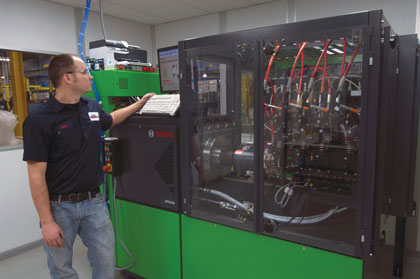Remanufactured, or reman, parts are fully tested to meet or exceed original OEM standards for like-new quality, are competitively priced, and cut down on repair times and costs.
When a machine is in need of repairs to any of its major systems, fleet owners have four options to consider concerning parts: new, rebuilt, reman, or used. Though all are viable options, owners and operators should consider reman parts, which help improve uptime and keep machines running smoothly.
Rebuilt parts are disassembled to the point of failure, with only the failed part being replaced; yet problems stemming from a failed part can often affect surrounding parts. To avoid any future problems, business owners need to address every component. Reman parts are completely disassembled and every component is checked against strict OE specifications. Any failed parts are refurbished and machined to like-new quality or replaced with 100-percent genuine OE parts.
Because of this, reman parts offer the assurance that every part is built to meet or exceed original OEM specifications. Not only do reman parts help lower the cost of ownership for contractors, they can also offer a best-in-class warranty, less machine downtime, and top-notch quality.
SAVING MONEY AND TIME
Business owners are constantly looking for ways to lower their total cost of ownership. Buying and using reman parts is an OEM-approved way of doing just that.
Reman parts are components of a machine that are fully restored to their original, like-new condition. Each individual part is disassembled, cleaned, and inspected, then all cores are updated to the latest specifications. Finally, the part is checked and remanufactured with replacements made to any components as needed.
In addition to offering a wide range of reman engines, fuel injection components, and hydraulics, many manufacturers now provide comprehensive reman parts coverage on their most popular equipment models, including Tier 3 and Tier 4 machines.
Each part is competitively priced, offering a great value while ensuring peak performance. Depending on the part and the machine, a reman part can cost up to 40 percent less than a comparable new part—all without sacrificing quality.
STANDING BEHIND QUALITY
When it comes to standing behind the quality of their reman products, some manufacturers also offer a “best-in-class” warranty that can be even better than new warranty coverage.
That warranty often includes labor costs if the work is done within the OEM dealer service shop, which means customers would have their part replaced without having to pay out-of-pocket for the work—providing fleet managers peace of mind and protection against additional costs during the life of the warranty.
A certified OEM dealer typically employs highly trained mechanics that have been trained on the products; have the right diagnostic and specialty tools required to do the job; have access to all the latest repair and service information; and can typically complete the repair in less time than a mechanic that isn’t certified to work on the machine.

Featured Image: Depending on the part and the machine, a remanufactured part can cost up to 40 percent less than a comparable new part.
Above: Remanufactured parts are tested extensively to ensure they meet original design performance standards.
LIMITING MACHINE DOWNTIME
Another way that reman parts lower the total cost of ownership for contractors is by limiting machine downtime. Instead of having a machine “out of service” while waiting for a component to be rebuilt, business owners can simply buy a reman part and have it be installed immediately upon receipt.
The quick and efficient installation of reman parts also decreases the need for fleet managers to rent a replacement machine to substitute for any down machine. This saves time and additional costs.
Fleet managers may also see an increased resale value of their machines due to the installation of reman parts. The quality of an OEM-provided part provides that value.
A QUALITY PRODUCT
In the past, reman parts were commonly associated with used parts that lacked quality and reliability. That stigma has since disappeared with the successful product assurance of reman parts throughout the industry.
In a typical remanufacturing process, as mentioned earlier, core parts are inspected and remade to original performance specifications using state-of-the-art techniques, strict salvage guidelines, advanced manufacturing systems, and unequaled quality control. Every part then receives a pass/fail grade after a rigorous testing process to ensure the customer is getting the best possible part.
Sometimes, a reman part is remade into a better version than the original OEM part. For example, a company launches a part in 1990 that is a good design, but in 2000, they make improvements to that design. Remanufacturing it now, in 2015, the company is able to incorporate the engineering improvements into the current remanufactured factory part, making it the best version available.
Not only are reman parts top quality, they’re also environmentally friendly. Remanufacturing is recognized as one of the highest forms of recycling because like-new products are produced while minimizing the impact on the environment. The products are kept out of landfills, and the entire process saves 80 percent of the energy that would have gone into producing a brand new part.
When dealing with a downed machine, fleet managers should consider reman parts. After all, critical parts are vital for uptime, productivity, and performance—they will help keep machines running while helping to reduce owning and operating costs. ■
About The Author: Kurt Coffey is the director of sales and marketing at CNH Industrial Reman. He can be reached at kcoffey@whyreman.com.
_________________________________________________________________________
Modern Contractor Solutions, August 2015
Did you enjoy this article?
Subscribe to the FREE Digital Edition of Modern Contractor Solutions magazine.

Choosing Reman Over the Rest


